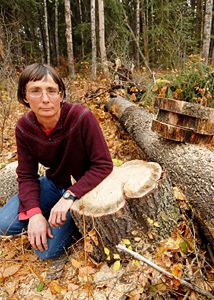Kathy Lewis
My research interests are primarily in the fields of forest pathology and microbial ecology. I study how disease-causing organisms interact with their physical and biological environments in forest ecosystems, and how forest management practices can affect those interactions. My hypothesis is that in natural multi-species sub-boreal systems, forest insects and pathogens control dynamics at the small scale (e.g., tree by tree replacement), and that the ecosystems have developed in the presence of these agents and therefore there is quasi-equilibrium between hosts and pathogens. Changes in composition or factors affecting tree vigour will affect mortality rate and gap sizes, and create disequilibrium.
Some of my current projects that involve tree-ring analyses include:

|
Kathy Lewis My research interests are primarily in the fields of forest pathology and microbial ecology. I study how disease-causing organisms interact with their physical and biological environments in forest ecosystems, and how forest management practices can affect those interactions. My hypothesis is that in natural multi-species sub-boreal systems, forest insects and pathogens control dynamics at the small scale (e.g., tree by tree replacement), and that the ecosystems have developed in the presence of these agents and therefore there is quasi-equilibrium between hosts and pathogens. Changes in composition or factors affecting tree vigour will affect mortality rate and gap sizes, and create disequilibrium. Some of my current projects that involve tree-ring analyses include: |
- Predicting decay and degrade rates in standing and fallen trees killed by mountain pine beetle. In this project we are using tree-ring analyses to determine time-since-death and time-since-fall of trees killed by mountain pine beetle.
- Examination of the distribution and severity of past outbreaks of Dothistroma septospora in northwestern B.C. and relationships with past climate. We are reconstructing past outbreaks of this foliar disease, and past climate, using tree-ring analyses.
- Research on small-scale disturbance patterns in spruce dominated forests, with emphasis on linking forest structure and disturbance agents using dendrochronological methods.
- An investigation of traditional land-use practices by the Tl’azt’en First Nation, and historic influence on stand and forest dynamics.